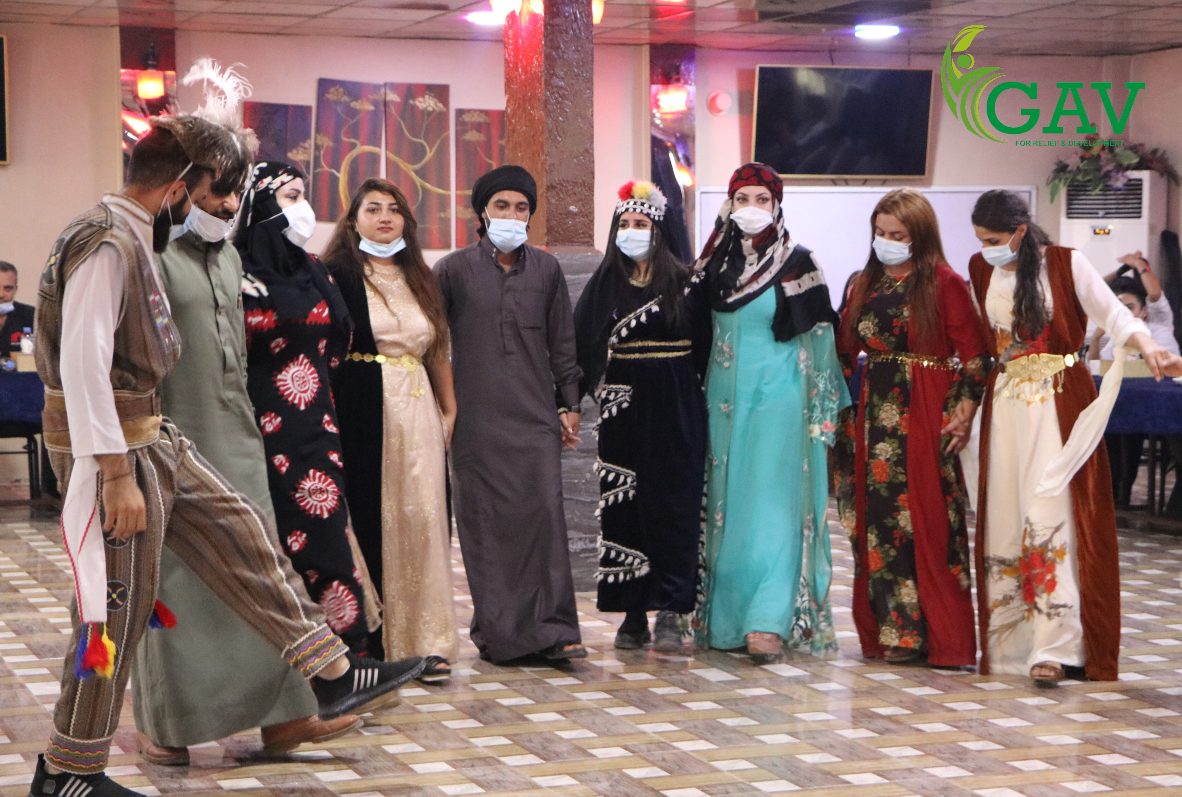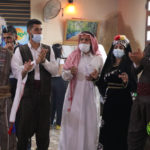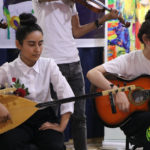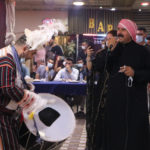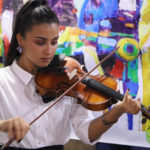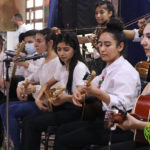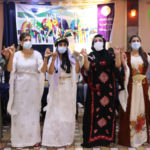The songs and music of the Jazira region form a common language that unites its inhabitants
English
As a language and a common denominator that unites different cultures, the music and songs carry general connotations and perceptions of the values, customs and ideas that characterize each of them.
Because songs and music are one of the most common things that bring together the residents of the Jazira region, because their words, melodies and musical arrangement carry cultural connotations, the GAV4RD organization held an artistic concert in the al-Khabour Hall in the city of Hasakah that focused on the contents of popular music and heritage songs of the Kurds, Arabs, Yezidis and Syriacs.
The artistic concert, which falls within the activities of the second phase of the project (Bayt al-Jazira – Mala Cizîrê – ܒܝܬܐ ܕܓܖܪܬܐ), was attended by a group of folk artists and bands to shed more light on the connotations and meanings of the words and the distinctive styles of each lyrical style, in an attempt to invest this diverse artistic culture to build unconventional bridges of communication between the different inhabitants of the Jazira.
Artist and musician, Muhammad Judi, said that the Kurdish music has contributed to increasing the spaces of communication between the various peoples of the Jazira.
Judi believed that traditional music and songs have a coherent pattern in the various cultures of the population of the Middle East in general, pointing out that one aspect of this interdependence is related to the maqams and musical melodies shared by the Kurds, Arabs, Syriacs and other residents.
According to Judi, this connection contributed to transforming music into a common language that brings together different cultures.
Commenting on the most important features of the Syriac heritage song, the singer, Vaskin said that that the Syriac lyrical format is characterized by its multiple maqams, which is based on the adaptation of many musical instruments to its performance, whether string, wind or percussion, in particular the lute, guitar, zither, and others.
According to Vaskin, the Syriac song deals with many topics, but in general it focuses on love, flirtation, and the glorification of folk epics that characterize the Syriac culture as one of the cultures of the original region.
With regard to the Arab heritage song, the popular singer, Rakan spoke about the status of mawwal and poetry, which prevailed during long periods and still maintains its position despite the many developments that occurred in the contemporary Arab singing style.
According to Rakan, the traditional songs provide a rich record of the values, customs and traditions that prevailed during different phases of the Jazira’s history.
The second phase of the project (Bayt al-Jazira – Mala Cizîrê – ܒܝܬܐ ܕܓܖܪܬܐ) includes organizing educational courses in the Kurdish and Syriac languages, as the language conveys the culture of society and the values that peoples believe in, which formed distinct identities over time that contributed to enriching life with its different colors and patterns, especially since it represents the first basis for any effective dialogue aimed at consolidating the values of coexistence, not to mention its guarantor role in protecting civil peace.
Youth teams from various communities of the Jazira will also participate in organizing cultural, social and artistic activities and joint dialogues to open new channels of communication between them, in order to complete the activities of the first phase of the project, which focused on enriching cultural differences as one of the most important factors in enriching the inclusive local culture.
The project (Bayt al-Jazira – Mala Cizîrê – ܒܝܬܐ ܕܓܖܪܬܐ), whose first phase started in August 2020, dealt with various topics in the lives of the people of the Jazira such as songs and music, traditional clothing and costumes, their connotations and symbols, political and cultural dialogues that dealt with the history of the various components, popular dishes and foods and the accompanying social rituals, in an attempt to enhance communication between the communities of the Jazira, including the Kurds, Arabs, Syriacs and Yezidis, by celebrating cultural differences and emphasizing the commonality that unites them such as memory and symbols, as one of the essential factors in building and preserving civil peace and promoting coexistence which has been based for hundreds of years, despite the ongoing conflict that the area has been going through for years.
Kurdî
Stran û mûzîka Cizîrê zimanê hevbeş ê ku pêkhateyên wê pev girêdide
Ji ber ku mûzîk ew zimanê hevbeş e ku wan çandên ciyawaz pev girêdide, nîşaneyên nirx, kevneşopî û ramanên ku wan jev cuda dike
Ji ber vê rola girîng a stran û mûzîkê ji hêla peyv, awaz û hevrêziya wan, dezgeha Gav şahiyeke hunerî li hola Xabûr li Bajarê Hesekê li dar xist ku li ser stranên gelêrî û kulturî yên Kurd, Ereb, Suryan û Êzdiyan rawestiya.
Di şahiya ku dikeve bin banê çalakiyên qonaxa duyemîn ji projeya (Mala Cizîrê) Gelek hunermendên gelêrî û tîmên mûzîkê beşdar bûn ku ronî avêtin ser wate û nîşaneyên gotinên mûzîkê yên pira girêdanê di navbera pêkhateyên Cizîrê de çêdikin.
Hunermend Mihemed Cûdî dibêje ku bi saya mûzîka kurdî girêdana di navbera pêkhateyên Cizîrê de xurtir bû.
Cûdî dibîne ku mûzîk û stranên gelêrî xwedî rêgezeke hevbeş e di navbera hemû çandên ciyawaz ên navçeya Rojhilata Navîn bi giştî de, ku li hêleke din ew pêlên stranan û awazên wan ku kurd, ereb û suryanî wan pev re parve dikin, yek ji aliyên girêdanê ne.
Ji ber wê û li gorî Cûdî mûzîk bû zimanê hevbeş ku çandên ciyawaz pev ve girêdid .
Hunermend Faskîn jî li ser taybetmendiyên strana gelêrî ya Suryanî wiha dibêje: Hevrêziya pêlên strana suryanî xwedî meqameyên curbicur in ku gelek alavên mûzîkê dixe bin xizmeta xwe de çi yên têl bin yan bayî bin yan jî bilêdan bin û bi taybet ûd, gîtar, qanûn û yên din.
Li gorî Faskîn strana suryanî gelek mijaran vedihewîne lê belê herî zêde balê dikêşe ser hezkirin, yarîbûn û pîrozkirina efsaneyên gelêrî ku çanda suryanî ya ku yek ji çandên herêmê ye cuda dikin.
Di derbarê strana erebî de jî, hunermend Rakan bal kişand ser awazên erebî û helbestên wan ku ta demeke dirêj serdest bûn, niha tevî guhertin û pêşketinên ku di strana erebî de çêbûne jî, lê rol û cihê xwe parastiye.
Li gorî Rakan stranên gelêrî bi nirx û kevneşopiyên herêmê yên ku di gelek qonaxan de derbas bûn, tijî ne.
Projeya Cizîrê ya duyemîn dê li ser perwerdeyên bi zimanên kurdî û suryanî kar bike ku ziman bi xwe wê çanda civakê û nirxên gel vediguhêze nifşên din ku bi demê re ew nasnameyên ciyawaz ên pêkhateyan çêkirin, ew nasname jî xwedî rol bûn di zengînkirina jiyana curbicur de. Li aliyekî din ziman bingeha her guftûgoyeke aktîf e ku armanca wê cîbicîkirina nirxên jiyana hevbeş a pêkhateyan û parastina aramî û aştîbûna civakî ye.
Dê gelek tîmên ciwanan ên pêkhateyên cizîrê di lidarxistin û çêkirina çalakiyên çandî, civakî, hunerî û guftûgoyan de beşdar bibin da ku rêyên din ên danûstandin û pevgirêdanê peyda bikin ku bikaribin çalakiyên qonaxa yekemîn temam bikin ên ku bi xwe jî li ser zengînkirina çandên ciyawaz kar dikirin ku wê çanda hevbeş a herêmê têrûtijî bikin û biparêzin.
projeya (Mala Cizîrê) Ku ji tebaxa sala borî de dest pê bibû, li ser jiyana pêkhateyên Cizîrê gelek mijar vehewandin û li ser kar kir mîna (stran- cilûbergên gelêrî û nîşaneyên wan- rûniştinên siyasî û guftûgoyên çandî yên li ser dîroka pêkhateyên Cizîrê – xwarinên taybet ên her pêkhateyekê û awayên oldarî û ayînzeyên pêkhateyan ….) . Ev hemû ji bo gurkirina girêdanê di navbera pêkhateyên Cizîrê yên ji kurd, ereb, suryan û êzdiyan e pêk tên, ji ber vê jî projeya yekemîn ew serbilindayîya bi zengîbûna çandên herêmê bingeh digirt da ku wê hevbeşiya ji tejaneya civakî û nîşaneyan pêk tê, biparêze ku wê tevna civakî ya ku vedigere sedên salan li hember vî şerê ku li navçeyê diqewime hembêz bike û gur bike.
- أجواء من حفل بيت الجزيرة الفني – GAV
- عازفتان من فرقة pêşeroj – GAV
- الفنان الشعبي راكان خلال حفل بيت الجزيرة الفني – GAV
- عازفة من فرقة pêşeroj – GAV
- عزف جماعي لأعضاء فرقة pêşeroj – GAV
- دبكة تراثية خلال حفل بيت الجزيرة الفني – GAV

